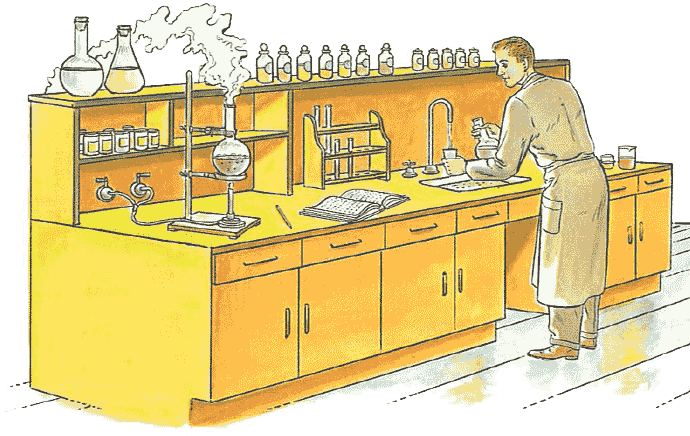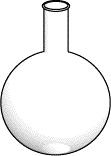
 Experiments & Measurements Experiments & Measurements |
|||||
| Chemistry Laboratory | Measurements in Chemistry |
Experiments & Measurements - 01
The Chemistry Laboratory
Experiments in chemistry in the laboratory are the primary means used by chemists to learn about matter, its properties and changes.
General Laboratory Facilities
The laboratory consists of chemical work desks which contain shelves, racks, drawers and empty space on which to work. A work desk generally also has a sink with water connection for washing and disposing liquids, a waste basket for disposing solid wastes, and a fuel gas connection facility for the burner. Chemicals are stored in labeled bottles and are collectively referred to as reagents.

Laboratory Apparatus
Some important apparatus used in the laboratory are given below.
| Apparatus | Description | Apparatus | Description |
|---|---|---|---|
 |
Bunsen Burner: A bunsen burner provides heat from a gas flame for experiments. |
Test Tube: Test tubes are used for holding small quantities of substances during reaction, with or without heating over a flame. Hard pyrex glass test tubes, called boiling tubes, do not crack on sustained heat. |
|
 |
Beaker: It is an open glass container with a lip for pouring liquids, and is used for storing/mixing chemicals. |
Watch Glass: It is a circular convexo-concave glass used generally for evaporating liquids, or for holding small samples. |
|
 |
Conical Flask: Also called Erlenmeyer flask, it is generally used for titrating, as it can be easily cleaned, stood and swirled. |
 |
Florence Flask: A long-necked round flask for holding liquids and easy swirling, with either a flattened base for standing, or rounded bottom for uniform heating. |
| Pipette: A pipette is a glass tube with which a small volume of liquid can be sucked in from one end for transferring to another container. Burette: It is a graduated glass tube with a tap at one end to measure out the amount of liquid run out from it. |
 |
Volumetric Flask: This flask is similar to a florence flask but has a longer neck which is graduated. It is used for measuring the volume of a liquid. |
|
 |
Funnel: A funnel is used for pouring liquids from one container to another. |
 |
Wash Bottle: A wash bottle is a plastic bottle with a nozzle. The bottle can be squeezed, thus forcing the contained liquid out of the nozzle. It is generally used for holding water to rise laboratory glassware. |
 |
Graduated Cylinder: Also called measuring cylinder, it is used for measuring the volume of a liquid |
 |
Test tube Holder: Made of wire, a test tube holder is used for safely holding test tubes, particularly when heat is being applied. |
There are many other apparatus forming a part of the laboratory, such as
- Test tube stand: Made of wood or plastic, it has holes and vertical bars for holding test tubes.
- Tripod stand: Made of cast iron, it has three legs and supports apparatus like flasks while heating.
- Wire gauge: It consists of an iron mesh with a thin asbestos sheet covering its central portion. It is kept over the tripod stand, and the apparatus to be heated is placed over the gauge. The gauge ensures even distribution of heat from the bunsen burner (placed below the gauge) to the apparatus.
- Mortar and pestle: The pestle is used to ground solid substances to a powder in the mortar, both of which are made of porcelain.
List of References
Brent, R, The Golden Book of Chemistry Experiments, NY, USA: Golden Press, 1960.
Bibliography
Brent, R, The Golden Book of Chemistry Experiments, NY, USA: Golden Press, 1960.
Das, P, Living Science – Chemistry for Class 6, Delhi, India: Ratna Sagar P. Ltd, 2005.
Glencoe, Glencoe Chemistry Matter and Change Laboratory Manual, student edn, OH, USA: Glencoe/McGraw-Hill, 2002.
Scaife, CWJ & Beachley (Jr), OT, Chemistry in the Laboratory, USA: Saunders College Publishing, 1987.
Uvarov, EB & Chapman, DR, A Dictionary of Science, 5th edn, UK: The Chauser Press, 1979.
Walker, PMB (ed.), Chambers Science and Technology Dictionary, New Delhi, India: Allied Publishers Pvt. Ltd, 1988.
Yates, RF, How to Make and Use a Small Chemical Laboratory, NY, USA: Norman W. Henley Publishin Company, 1926.
| Chemistry Laboratory | Measurements in Chemistry | ||||
 Experiments & Measurements Experiments & Measurements |
 High School
High School Mathematics
Mathematics Sets & Basic Operations
Sets & Basic Operations